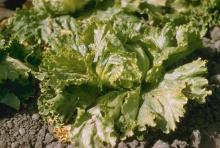Cause This viral disease is soilborne and transmitted by the oomycete, Olpidium virulentus (formerly known as O. brassicae). Mirafiori lettuce big-vein virus (MLBVV) (formerly known as mirafiori lettuce virus) has been recently identified as a causal agent of big vein while lettuce big-vein associated virus (LBVaV) (formerly known as lettuce big-vein virus), previously thought to cause big vein, is yet to be confirmed as a causal agent. Both viruses are commonly associated with big vein affected lettuce plants so both may play a role. Wet, cool conditions favor the fungus-like vector, which has a very wide host range. The virus can survive at least eight years in soil within resting sporangia. Uninfected vector strains acquire the virus upon entry in infected plants. New plantings may develop the disease due to weedy hosts acting as reservoirs of the vector and/or virus, including sow thistle (Sonchus oleraceus) and perhaps Chenopodium spp. Various species of Lactuca as well as Chicorium endivia (endive) are affected by big vein. Both MLBVV and LBVaV were detected in leaves of lettuce, garland chrysanthemum (Chrysanthemum coronarium), tomato, and eggplant while MLBVV has been reported in cucumber, and LBVaV in onion, Welsh onion (A. fistulosum), and Chinese chive (A. tuberosum).
Symptoms Leaf veins appear decidedly larger because of clear areas along the veins. Leaves may be puckered and mottled. Heads fail to size up. Often only a rosette of leaves forms, but no head. Low temperatures favor the disease; it is evident in early and late crops much more than in midsummer crops.
Cultural control
- On badly infested land, use long rotations.
- Avoid early planting in wet soil or poorly draining fields with a history of disease.
- Select land not previously planted to lettuce, if possible.
- Removing crop residue, rather than working it into the soil, prevents increase of the disease.
- Steam treatment of soil for seedbeds or in the greenhouse will reduce the population of vector and virus.



